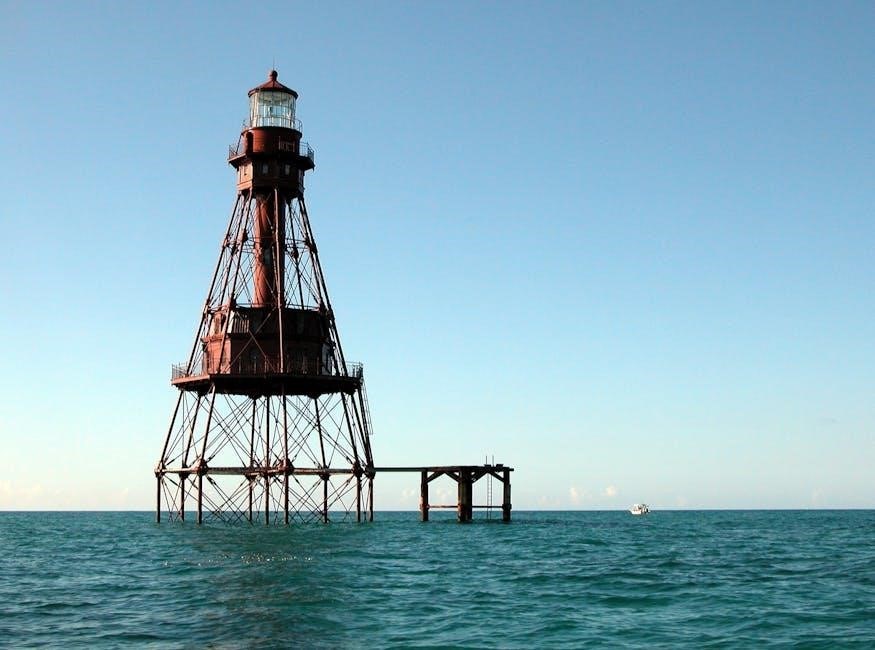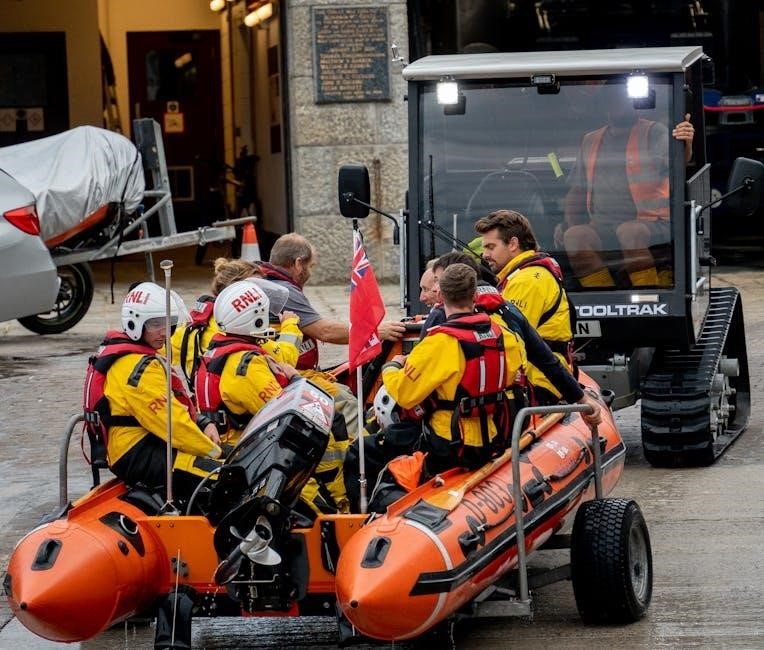Trailer boat guides are essential accessories that simplify the process of loading and unloading your vessel, ensuring safety and preventing damage. They provide alignment assistance, making the task easier even in windy conditions, and protect your boat from impact during transport, enhancing your overall boating experience.
1.1 What Are Trailer Boat Guides?
Trailer boat guides are accessories designed to assist in aligning and securing your boat during loading and unloading from a trailer. Typically made of durable materials like steel, aluminum, or PVC, these guides come in adjustable or fixed designs. They attach to the trailer and provide a clear visual and physical reference to help center the boat, reducing the risk of damage to both the vessel and the trailer. Available in padded, carpeted, or post-style options, trailer guides enhance safety and simplify the docking process, especially in challenging conditions like wind or low visibility.
1.2 Importance of Trailer Boat Guides for Safe Boat Handling
Trailer boat guides are indispensable for safe and efficient boat handling, preventing costly damage during loading and unloading. They provide clear alignment assistance, reducing the risk of impact with the trailer’s frame or rollers. This protection is especially crucial in windy or low-visibility conditions, where precise maneuvering is challenging. By keeping the boat centered, guides minimize the effort required, making the process less stressful. Durable materials like PVC, aluminum, or steel ensure long-lasting reliability. Investing in quality trailer guides not only safeguards your boat but also enhances your overall boating experience by streamlining operations and reducing the likelihood of accidents or repairs.

Types of Trailer Boat Guides
Trailer boat guides come in various designs, including adjustable, heavy-duty steel, padded, and aluminum or stainless steel options. Each type offers unique benefits for safe and efficient boat handling.
2.1 Adjustable Design Trailer Guides
Adjustable trailer guides are versatile and convenient, accommodating boats of varying sizes. They feature movable components, allowing precise alignment to fit different vessel dimensions. Constructed from durable materials like aluminum or steel, these guides often include padded surfaces to protect the boat from scratches. Their adaptability makes them ideal for boat owners with multiple vessels or those who frequently switch between different boats. Easy to install and adjust, they provide consistent support during loading and unloading, ensuring safe and efficient handling of your boat. This design is particularly useful in windy conditions, helping maintain control and alignment effortlessly.
2.2 Heavy-Duty Steel Trailer Guide Poles
Heavy-duty steel trailer guide poles are designed for exceptional strength and durability, ideal for larger boats and challenging conditions. Constructed from robust materials, these guides provide superior stability and alignment support. They often feature rust-resistant coatings, such as galvanized steel, to withstand harsh marine environments. Their sturdy design ensures reliable performance, even with heavy loads, and helps prevent damage to both the boat and trailer. These poles are a practical choice for boat owners seeking long-lasting, low-maintenance solutions to simplify the loading and unloading process, ensuring safety and precision every time.
2.3 Padded and Carpeted Guide-Ons
Padded and carpeted guide-ons offer superior protection for your boat’s hull during loading and unloading. The soft, cushioned surfaces gently guide the vessel into place, preventing scratches and abrasions. These guide-ons are particularly useful for fiberglass or aluminum boats, which are prone to damage. The carpeted material also reduces noise and provides a secure fit, minimizing movement during transport. Available in various sizes, they are easy to install and maintain, ensuring a safe and hassle-free boating experience. Their protective features make them a popular choice among boat owners seeking to preserve their vessel’s condition and extend its lifespan.
2.4 Aluminum and Stainless Steel Guide Poles
Aluminum and stainless steel guide poles are durable, corrosion-resistant options for boat trailers. These materials are lightweight yet strong, ensuring long-lasting performance in marine environments. Aluminum guide poles are often favored for their rust-proof properties, while stainless steel offers unmatched durability and strength; Both options are designed to withstand harsh weather conditions and heavy use. Their sleek design and versatility make them suitable for various boat sizes and trailer configurations. These guide poles provide reliable support during loading and unloading, ensuring consistent alignment and reducing the risk of damage to your boat. They are a practical choice for boat owners seeking both functionality and longevity.

How to Choose the Best Trailer Boat Guides
Selecting the right trailer boat guides involves considering material, adjustability, and durability. Look for options that fit your boat size, budget, and specific needs to ensure reliability and ease of use.
3.1 Factors to Consider When Selecting Trailer Guides
When selecting trailer guides, consider durability, material quality, and adjustability. Look for guides made from rust-resistant materials like aluminum or galvanized steel. Ensure they fit your boat’s size and trailer type. Adjustable designs offer versatility for different boat lengths and configurations. Ease of installation and maintenance are also key factors. Opt for padded or carpeted guide-ons to protect your boat’s hull from scratches. Visibility, especially in windy or low-light conditions, is crucial, so choose guides with reflective or high-visibility features. Finally, assess the weight capacity and ensure the guides align with your boat’s centerline for proper loading and unloading.
3.2 Material Options: Steel, Aluminum, and PVC
Trailer guides are available in steel, aluminum, and PVC, each offering unique benefits. Steel guides are durable and heavy-duty, ideal for large boats, with galvanized options resisting rust. Aluminum guides are lightweight, corrosion-resistant, and suitable for smaller vessels. PVC guides are non-marring and easy to install, providing excellent protection against scratches. Carpeted or padded options add extra hull protection. Consider the material’s strength, weight capacity, and resistance to environmental factors like saltwater or heavy use. Choose based on your boat’s size, trailer type, and personal preference for durability, maintenance, and ease of handling.
3;3 Adjustability and Versatility for Different Boat Sizes
Adjustable trailer guides offer versatility, accommodating various boat sizes and shapes. They allow precise alignment, ensuring a secure fit regardless of the vessel’s dimensions. Padded or carpeted surfaces protect the hull from scratches, while telescoping poles enable easy customization. Heavy-duty options are ideal for larger boats, while lightweight designs suit smaller craft. Versatility ensures compatibility with different trailer configurations, making them a practical choice for boat owners with multiple vessels. Proper adjustment enhances safety and efficiency, simplifying the loading and unloading process. This adaptability makes adjustable guides a valuable investment for maintaining your boat’s condition and streamlining trailer operations.

Installation and Maintenance of Trailer Guides
Proper installation and maintenance ensure trailer guides function effectively. Adjust guides to align with your boat’s hull, lubricate moving parts, and protect against rust. Regular inspections prevent wear and tear, ensuring safe and smooth operations.
4.1 Step-by-Step Installation Guide
To install trailer guides, start by positioning them on the trailer frame, ensuring alignment with your boat’s hull. Secure the guides using mounting hardware, typically bolts or clamps. Adjust the height and angle to fit your boat’s dimensions, ensuring they provide proper support. Tighten all bolts firmly to prevent movement. For adjustable guides, test their alignment by simulate loading and unloading your boat. Finally, inspect the installation to ensure stability and correct positioning. Proper installation ensures smooth loading and unloading, protecting your boat from damage during transport. Regular inspections and adjustments are recommended for optimal performance.
4.2 Tips for Maintaining Trailer Guides
Regularly inspect trailer guides for damage, rust, or wear. Clean them with a mild detergent to remove dirt and grime. Lubricate moving parts to ensure smooth operation. For metal guides, apply rust-inhibiting coatings to protect against corrosion. Check and tighten bolts and fasteners periodically to prevent loosening. Avoid using harsh chemicals that may damage materials. For padded guides, ensure the carpeting or padding remains intact to prevent scratching your boat. Store guides in a dry place during off-season to reduce moisture exposure. Regular maintenance ensures longevity and optimal performance of your trailer guides, providing consistent support for your boat.
4.3 Common Mistakes to Avoid During Installation
Avoid improper alignment of trailer guides, as this can lead to poor boat centering and potential damage. Never skip rust-proofing metal components, especially in coastal areas. Using incorrect fasteners or overtightening can damage the trailer or guides. Ensure guides are level and evenly spaced for balanced support. Overlooking manufacturer instructions can result in unsafe installations. Avoid placing guides too far apart, as this reduces effectiveness. Never install damaged or worn-out guides, as they compromise safety. Finally, always test the setup by loading and unloading the boat to ensure proper functionality and alignment before heading out.

Loading and Unloading Your Boat with Trailer Guides
Trailer guides streamline the loading and unloading process, ensuring proper alignment and reducing the risk of damage. They enhance safety and efficiency, even in challenging conditions like wind.
5.1 How Trailer Guides Simplify the Loading Process
Trailer guides significantly simplify the loading process by providing clear alignment assistance, reducing the effort required to position the boat correctly. They act as visual cues, helping to center the vessel on the trailer, even in windy or low-visibility conditions. Padded or carpeted surfaces protect the boat from scratches and abrasions, while adjustable designs accommodate various boat sizes. This streamlined process minimizes the risk of damage and ensures a safer, more efficient transfer, allowing you to focus on enjoying your time on the water rather than struggling with alignment. Guides also enhance stability, making the entire process quicker and less stressful for boat owners.
5.2 Tips for Aligning Your Boat on the Trailer
Aligning your boat on the trailer can be made easier with a few key strategies. Start by moving slowly and maintaining a straight approach to the trailer. Use the guide poles or guide-ons as visual markers to center the boat. Ensure the vessel is aligned with the trailer’s centerline before loading. If possible, have someone assist by guiding you from the dock or shore. Once aligned, secure the boat with straps or tie-downs to prevent shifting during transport. Proper alignment not only prevents damage but also ensures a stable and safe towing experience, making every trip to the water more enjoyable.
5.3 Using Guide Poles in Windy Conditions
Guide poles are invaluable in windy conditions, providing clear visual cues to help align your boat with the trailer. Their sturdy design keeps the boat centered, reducing the risk of it being pushed off-course by strong gusts. The bright colors or reflective materials on many guide poles enhance visibility, making alignment easier even in low-light or turbulent conditions. By offering consistent support, guide poles minimize the strain of loading and unloading, ensuring your boat stays secure and protected from potential damage caused by wind-related misalignment. This makes them an essential tool for maintaining control and safety in challenging weather.

Safety Considerations When Using Trailer Guides
Trailer guides are crucial for preventing damage to your boat and trailer. They help keep your vessel centered, avoiding misalignment and reducing costly repairs during transport.
6.1 Preventing Damage to Your Boat and Trailer
Trailer boat guides play a vital role in preventing damage to both your vessel and trailer. By keeping the boat centered during loading and unloading, they minimize the risk of costly repairs. Guides protect against impacts with the trailer’s frame or roller brackets, especially in windy conditions. Durable materials like aluminum and stainless steel ensure longevity and resistance to rust, while padded options offer extra cushioning to safeguard your boat’s finish. Proper alignment and support are key to avoiding scratches, dents, and structural damage, ensuring your boat remains in pristine condition for years of reliable use.
6.2 Best Practices for Securing Your Boat
Properly securing your boat to the trailer is crucial for safe transport and preventing shifting. Use high-quality straps or tie-downs to ensure the boat is firmly attached. Always engage the trailer’s winch and lock the coupler to prevent unintentional detachment. Double-check all connections before towing. Regularly inspect straps, chains, and bolts for wear and tear. Tighten all components to avoid loosening during transit. Consider using padded guide-ons to reduce friction and protect the boat’s hull. Ensure the trailer is level to distribute weight evenly, enhancing stability and control while towing. This ensures a safe and secure transport experience for your vessel.
6.3 Common Safety Mistakes to Avoid
When using trailer boat guides, avoid common mistakes that could compromise safety. Neglecting to properly align the boat with the trailer can lead to misloading and potential damage. Failing to secure the boat with straps or tie-downs increases the risk of shifting during transport. Overloading the trailer beyond its capacity can cause structural stress and instability. Ignoring worn-out or corroded guide poles can result in failure during loading or unloading. Always ensure the trailer is on level ground and avoid rushing the process. Regular maintenance of the guides and trailer components is essential to prevent accidents and ensure safe operations.

Product Reviews and Recommendations
Top-rated trailer guides offer durability and ease of use; VEVOR and Fulton guides are highly recommended for their sturdy materials and effective alignment assistance. Customers praise their reliability, making them a top choice for boating enthusiasts. Expert reviews highlight their value and performance.
7.1 Top-Rated Trailer Guide-Ons and Poles
Top-rated trailer guide-ons and poles are essential for secure boat alignment and easy loading. VEVOR and Fulton guides are highly recommended for their durability and performance. Made from sturdy materials like steel, aluminum, and PVC, these guides offer excellent rust resistance and long-lasting reliability. Features such as carpeted boards and adjustable designs ensure a snug fit and protection for your boat. Customers praise these products for their ease of use, especially in windy conditions, and their ability to simplify the loading process. Whether you own a fishing boat or a sailboat, these guide-ons and poles are a worthwhile investment for safe and efficient boating experiences.
7.2 Best Adjustable and Padded Options
For enhanced protection and versatility, adjustable and padded trailer guide-ons are highly recommended. These options feature cushioned surfaces to prevent scratches and provide a snug fit for your boat. Adjustable designs allow customization to suit various boat sizes and trailer configurations, ensuring optimal alignment. Padded guide-ons are particularly ideal for sensitive hulls, offering extra protection during loading and unloading. Brands like VEVOR and Fulton offer top-rated models with durable materials and rust-resistant coatings. These guides are easy to install and maintain, making them a practical choice for boat owners seeking both safety and convenience. They enhance the overall boating experience with reliable performance.
7.3 Affordable and Durable Guide Kits
Affordable and durable guide kits are perfect for boat owners seeking cost-effective solutions without compromising on quality. These kits often include adjustable or fixed guide-ons made from robust materials like steel or PVC, ensuring long-lasting performance. Many options, such as the VEVOR Short Bunk Guide-Ons, feature carpeted boards for hull protection and come with complete mounting hardware. They are easy to install and designed to withstand harsh marine conditions. These kits are ideal for small to medium-sized boats, offering excellent value for their price. By providing reliable support and alignment, they help safeguard your boat during loading and transport, making them a practical investment.

Caring for Your Boat Trailer and Guides
Regular cleaning and lubricating of trailer components ensure smooth operation. Protecting against rust and corrosion with products like Salt Off keeps your trailer in excellent condition. Proper storage during off-season maintains functionality and longevity, ensuring your boat and trailer remain ready for adventures year-round.
8.1 Cleaning and Lubricating Trailer Components
Regular cleaning and lubricating are crucial for maintaining trailer functionality. Rinse the trailer with fresh water after use to remove dirt and salt residue. Use a marine-grade cleaner for tough stains and apply lubricants to moving parts like hinges and rollers. Protect metal components from rust with products like Salt Off. Lubricating axles and other friction points ensures smooth operation. Proper maintenance prevents corrosion, extends the trailer’s lifespan, and ensures safe, reliable performance for years of boating adventures. Keep your trailer in top condition to safeguard your boat and guarantee hassle-free launches and retrievals.
8.2 Protecting Against Rust and Corrosion
Protecting your trailer from rust and corrosion is vital for longevity. After each use, rinse the trailer thoroughly with fresh water to remove salt and debris. Dry it completely, especially in crevices, to prevent moisture buildup. Apply marine-grade rust inhibitors or coatings to metal parts annually. Use products like Salt Off to combat corrosion effectively. Regular inspections can catch early signs of rust, allowing for prompt treatment. Neglecting corrosion can lead to structural weaknesses, compromising safety and requiring costly repairs. Proactive protection ensures your trailer remains durable and reliable for years of trouble-free boating adventures.
8.3 Storing Your Trailer During Off-Season
Properly storing your trailer during the off-season ensures it remains in great condition. Clean and dry the trailer thoroughly, paying attention to crevices and guide components. Apply rust inhibitors to metal parts and lubricate moving elements. Store in a dry, shaded area or cover it to protect from UV damage. Avoid direct ground contact by using blocks or a stand to prevent moisture buildup. Check and repair any damaged or worn-out parts before storage. Regular inspections during storage can help prevent issues. Proper care during the off-season ensures your trailer and guides are ready for the next boating season.
Troubleshooting Common Issues
Identify misaligned guides, rust, or bent poles. Adjust or replace damaged parts promptly. Regular inspections prevent major repairs and ensure smooth boat loading and unloading processes.
9.1 Fixing Misaligned Trailer Guides
Misaligned trailer guides can cause loading difficulties and potential boat damage. To fix this, start by inspecting the guides for any obstructions or debris. Loosen the mounting bolts and adjust the guides to ensure proper alignment with your boat’s hull. Use a level tool to verify straightness and tighten the bolts securely. Regularly cleaning and lubricating moving parts can prevent misalignment. If the issue persists, consider replacing worn-out components. Properly aligned guides ensure smooth loading, reduce stress on the trailer, and protect your boat from scratches or dents during transport. Maintain your guides to avoid recurring problems and ensure safe boating experiences.
9.2 Repairing Damaged Guide Poles
Repairing damaged guide poles is crucial for maintaining proper trailer functionality. Start by assessing the extent of the damage. For minor dents or scratches, clean the area thoroughly and apply a rust-inhibiting coating. If the pole is bent, carefully straighten it using a wrench or pliers. Replace any broken or corroded components, such as pads or brackets, with durable, marine-grade materials. For severe damage, consider welding or replacing the entire guide pole. Regular inspection and timely repairs ensure optimal performance, preventing further issues during loading and unloading. A well-maintained guide pole enhances safety and protects your boat from potential damage.
9.3 Solving Loading and Unloading Problems
Loading and unloading issues can often be resolved by ensuring proper alignment of your boat with the trailer. Use guide poles to help center the vessel, especially in windy conditions. If the boat consistently veers off, adjust the guide poles’ height or position for better alignment. Regularly clean and lubricate the trailer’s rollers and bunks to reduce friction. For stubborn cases, apply a marine-grade lubricant to the rollers. If the boat sticks during unloading, gently rock it back and forth while applying steady pressure. Ensure the trailer is properly submerged during launching to facilitate smooth sliding. Always inspect the trailer and guides for damage or debris before use.
Trailer boat guides are indispensable for safe and efficient boat handling, offering ease of use, protection, and enhanced safety during transport. Invest in quality guides for a hassle-free experience.
10.1 Final Thoughts on Trailer Boat Guides
Trailer boat guides are a cornerstone of safe and efficient boat handling, offering unmatched convenience and protection. Their ability to simplify loading and unloading, even in windy conditions, ensures a stress-free experience. By preventing damage to both your boat and trailer, these guides prove to be a wise investment. Durable materials like aluminum and steel guarantee long-lasting reliability, while adjustable designs cater to various boat sizes. Whether you’re a seasoned pro or a novice, quality trailer guides enhance your boating adventures by eliminating alignment hassles and ensuring your vessel stays secure. They truly are a boater’s best friend for effortless water outings.
10.2 Encouragement to Invest in Quality Trailer Guides
Investing in high-quality trailer guides is a wise decision for any boat owner. They offer durability, ensuring long-term protection for your boat and trailer. Quality guides reduce stress during loading and unloading, even in windy conditions, and prevent costly damage. With options like adjustable, padded, and heavy-duty designs, you can find the perfect fit for your vessel. While initial costs may seem higher, the long-term benefits of reduced maintenance and enhanced safety make them a worthwhile investment. Prioritizing quality ensures your boating adventures remain enjoyable and hassle-free for years to come.
Bonus: Additional Resources
Explore recommended reading, online forums, and communities dedicated to boat trailer maintenance and accessories. These resources offer valuable insights and tips for enhancing your trailer guide system.
B1. Recommended Reading for Boat Trailer Maintenance
For in-depth knowledge, consider top-rated books and guides on boat trailer maintenance. These resources often include step-by-step instructions for installing and caring for trailer guides, rollers, and other components. Popular options like “The Complete Guide to Boat Trailers” and “Boat Trailer Maintenance Made Easy” provide practical tips for DIY enthusiasts. Additionally, online forums and communities, such as those dedicated to boat enthusiasts, offer real-world advice and troubleshooting solutions. These materials can help you optimize your trailer’s performance and ensure your boat stays secure and protected during transport and storage.
B2. Online Communities for Boat Enthusiasts
Engage with online forums and communities dedicated to boating and trailer maintenance. Platforms like Boat Forums, The Hull Truth, and Facebook groups for boat enthusiasts offer valuable insights and advice. These communities often discuss trailer guide installation, maintenance tips, and troubleshooting common issues. Members share real-world experiences, product recommendations, and DIY solutions. Participating in these forums can help you stay informed about the latest trends and best practices for caring for your boat trailer and guides. They’re great resources for connecting with fellow boaters and resolving challenges efficiently.
